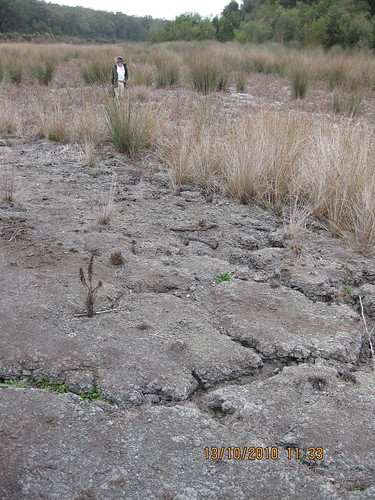View all Thirlmere Lakes photos
What has happened to the water in Thirlmere Lakes? What was once a vibrant wetlands enjoyed by families and wildlife has disappeared, leaving mud and very little else.
The Lakes are special because they have survived 15 million years without being fed by an active river system. They receive some groundwater runoff, and are believed to have an extensive groundwater system, based on sandstone aquifers that characterise the region.
The Department of Environment concedes in its management plan the hydrology of the Lake system is poorly understood. It is now urgent to solve these mysteries and get to the cause of the problem.
http://starkessays.com/online-essay-writer/
The above photo shows the extent of the drying that has occurred.
Rivers SOS has received advice from Dr Brian Marshall, retired professor of structural and engineering geology, and a past president and current committee member of the Blue Mountains Conservation Society. Dr Marshall’s assessment follows:
The lakes are sourced from surface water and register the local water table. They should have recharged by now, as was the case after previous severe droughts, but instead the water levels continue to drop.
Something other than drought is causing the loss: mining has possibly caused fracturing of the local aquiclude (rock barrier) beneath the lakes, facilitating hydraulic connectivity between the lakes and the deeper aquifers affected by mine impacts. Water may now be migrating through a fracture network (permeability paths) extending both vertically and laterally (vertilaterally) down to the level of the mine workings.
Over time the rate of flow along the fractures increases along with the vertilateral connectivity, while mine workings form a low pressure “sump.” The role of the low pressure “sump” is increased by the pumping out of water from the mine workings at a rate of 4 megalitres per day from Xstrata’s Tahmoor Colliery into the nearby Bargo River. This ongoing dewatering of the mines could be a significant factor in the water loss from the Thirlmere Lakes.
Any theory of loss would be hard to prove. Isotopic tracers could be used to gauge where the water is going, but given the slow rate of flow through the permeability network this could take several years to provide a result.
Also, remediation could be extremely difficult if mining-induced enhanced permeabiltiy is the cause of loss. A full or partial grout curtain to block flow could be considered, but this would be very expensive and perhaps not effective in the long run. The use of epoxy filler if specific cracks could be located is also very expensive and environmentally damaging.
Yet another possibility could be to pump the water, once suitably treated, to the lakes until mining is finished, the workings fill up with water, and a more stable hydrologic regime is established.
Rivers SOS is calling for an examination of the lakes by the Australian Committee of the International Union for the Conservation of Nature. Rivers SOS believes that the impact of mining on the Thirlmere Lakes should be identified with great urgency, before more damage is done.
The following is a virtual tour of the Lakes, provided by the Greater Blue Mountains World Heritage Experience.
Here are the most recent updates:
[catlist name=”Thirlmere Lakes” orderby=date numberposts=50 excerpt=yes]


We went to visit the lakes Sunday 18th July 2011. I was horrified at the water level and at the lack of publicity – We did not know there was a problem. Man has, once again, destroyed a natural wonder and denies all responsibility and does nothing to fix it. How can we in todays age accept this negligence without making the delinquent pay. A full investigation is demanded and all stakeholders held accountable and a solution found – not matter the cost. Turning a blind eye is not acceptable. IF the coal mines are responsible then why are they not bankrupt by all the fines and restoration required??
I was one of those children who back in the late 60’s and early 70’s used to swim in these lakes. Large mining companies need to understand their impact on the environment both immediate and long term. As a mining island I am extremly concerned about the impact of mining, coal seam gas extraction and other activities which large corporations are deaf and blind to hearing the general public their impacts on our natural environment. Its seems to me the more dollars a corporation has the louder their voice becomes. Enivironmentalist need to maintain the rage.
Gayle Cusack: Same here, Thirlmere and Picton in where I would say I am from, same era.
I found this information while researching the effects of csg mining on aquifers in my new home 40 yrs later(Lismore), and its distressing!, Thirlmere lakes is not looking like I remember it at all!, this isn’t csg mining but just another reason to stop destroying our children’s land, that is A-LOT of water vanished.
I have never thought of myself as an environmentalist or an activist but many are being branded as just that, for questioning what the hell is going on with stark evidence before their eyes.
Why do permanent damage, or risk doing it to what we are largely made of, water.